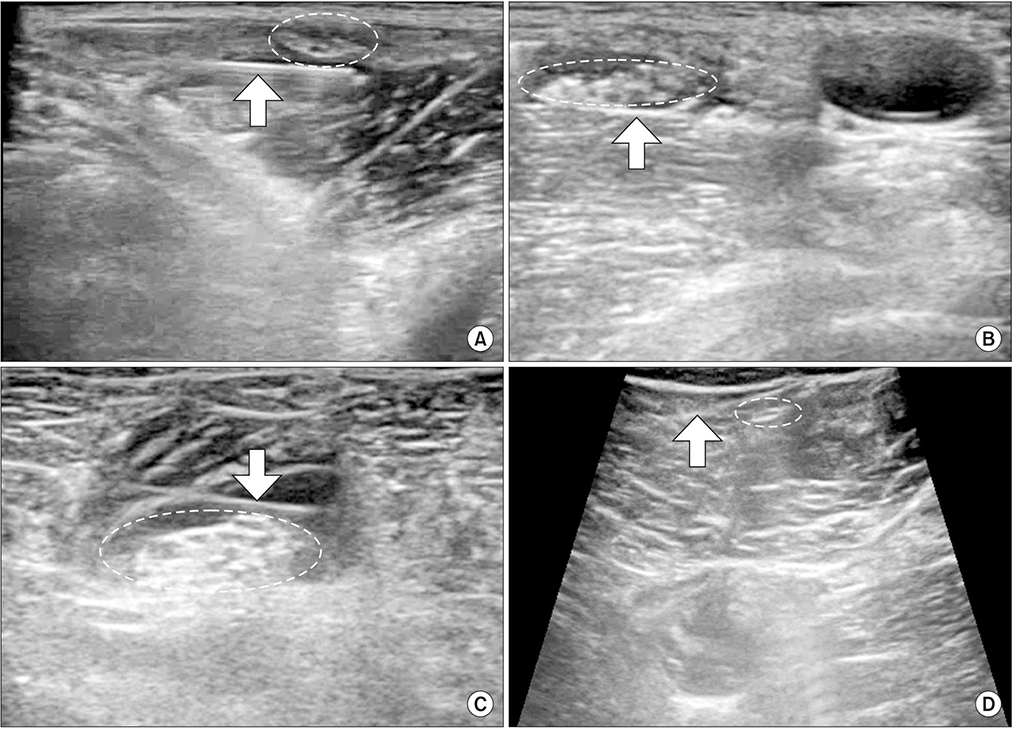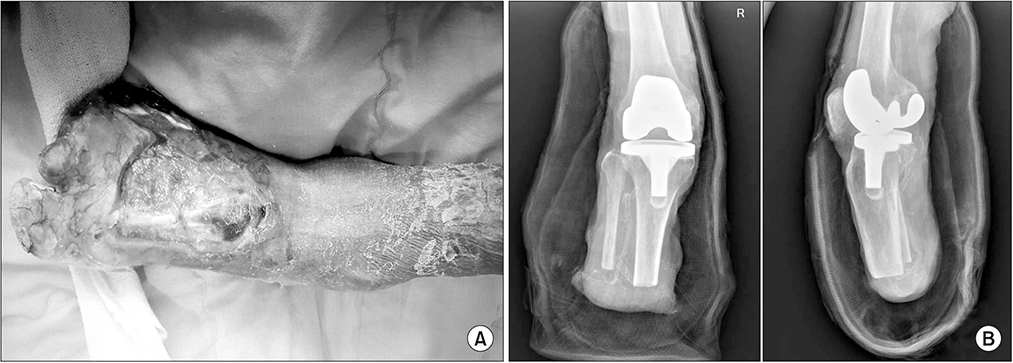J Korean Orthop Assoc.
2018 Oct;53(5):435-442. 10.4055/jkoa.2018.53.5.435.
Ultrasound-Guided Regional Nerve Block in Below-Knee Amputation
- Affiliations
-
- 1Department of Orthopaedic Surgery, Chungnam National University School of Medicine, Daejeon, Korea. faschan@daum.net
- KMID: 2424103
- DOI: http://doi.org/10.4055/jkoa.2018.53.5.435
Abstract
- PURPOSE
This study compared the clinical results of an ultrasound (US)-guided regional nerve block with those of general anesthesia in below-knee amputation (BKA) surgery. In addition, the 1-year mortality rate of BKA patients was evaluated in relation to the preoperative comorbidity and postoperative hemoglobin level.
MATERIALS AND METHODS
Among 47 patients who underwent BKA between January 2011 and August 2016, 18 patients in the US-guided regional nerve block group (group 1) and 29 patients in the general anesthesia group (group 2) were analyzed retrospectively and compared. For the clinical assessment, the 30-day mortality, 1-year mortality, postoperative hemoglobin level, and postoperative complications of both groups were investigated. The visual analogue scale (VAS) pain scores at postoperative 1, 6, and 12 hours for both groups were evaluated. The 1-year mortality of BKA patients was also evaluated in relation to the preoperative comorbidity and postoperative hemoglobin level (hemoglobin < 7 g/dl).
RESULTS
Significant differences in the 30-day mortality were observed between the two groups (p=0.023). Group 1 showed a higher 30-day mortality but the 1-year mortality was similar in both groups (p=0.051). The postoperative hemoglobin level was similar in the two groups (p=0.085). The VAS pain scores for the postoperative 1-hour and 6-hour differed significantly between the two groups (p < 0.001). The VAS pain scores for postoperative 12-hour showed no significant difference (p=0.10). The 1-year mortality rate of both groups was not affected by hypertension, diabetes mellitus, arteriosclerosis obliterans, and postoperative hemoglobin less than 7 g/dl, but was affected by chronic kidney disease (CKD) (Pearson's chi-square=14.39, p < 0.05).
CONCLUSION
Although US-guided regional nerve block showed comparable 1-year mortality and postoperative hemoglobin levels compared to general anesthesia in BKA, it showed better results in postoperative 1, 6 hour pain control than general anesthesia. The 1-year mortality of BKA was affected by CKD. Therefore, careful consideration is needed for patients with CKD before undergoing BKA regardless of the anesthetic methods.
Keyword
MeSH Terms
Figure
Reference
-
1. Goodney PP, Beck AW, Nagle J, Welch HG, Zwolak RM. National trends in lower extremity bypass surgery, endovascular interventions, and major amputations. J Vasc Surg. 2009; 50:54–60.
Article2. Ziegler-Graham K, MacKenzie EJ, Ephraim PL, Travison TG, Brookmeyer R. Estimating the prevalence of limb loss in the United States: 2005 to 2050. Arch Phys Med Rehabil. 2008; 89:422–429.
Article3. Aragón-Sánchez J, Hernández-Herrero MJ, Lázaro-Martínez JL, et al. In-hospital complications and mortality following major lower extremity amputations in a series of predominantly diabetic patients. Int J Low Extrem Wounds. 2010; 9:16–23.
Article4. Aulivola B, Hile CN, Hamdan AD, et al. Major lower extremity amputation: outcome of a modern series. Arch Surg. 2004; 139:395–399. discussion 399.5. Subramaniam B, Pomposelli F, Talmor D, Park KW. Perioperative and long-term morbidity and mortality after above-knee and below-knee amputations in diabetics and nondiabetics. Anesth Analg. 2005; 100:1241–1247. table of contents.
Article6. Lin R, Hingorani A, Marks N, et al. Effects of anesthesia versus regional nerve block on major leg amputation mortality rate. Vascular. 2013; 21:83–86.
Article7. Bech B, Melchiors J, Børglum J, Jensen K. The successful use of peripheral nerve blocks for femoral amputation. Acta Anaesthesiol Scand. 2009; 53:257–260.
Article8. Kim YM, Joo YB, Kang C, Song JH. Can ultrasound-guided nerve block be a useful method of anesthesia for arthroscopic knee surgery? Knee Surg Sports Traumatol Arthrosc. 2015; 23:2090–2096.
Article9. Marcus AJ, Lotzof K, Kamath BS, et al. A new approach: regional nerve blockade for angioplasty of the lower limb. Cardiovasc Intervent Radiol. 2006; 29:235–240.
Article10. Song JH, Kang C, Hwang DS, Hwang JM, Shin BK. Fentanyl patches to supplement ultrasound-guided nerve blocks for improving pain control after foot and ankle surgery: a prospective study. J Foot Ankle Surg. 2016; 55:121–124.11. Yazigi A, Madi-Gebara S, Haddad F, Hayeck G, Tabet G. Intraoperative myocardial ischemia in peripheral vascular surgery: general anesthesia vs combined sciatic and femoral nerve blocks. J Clin Anesth. 2005; 17:499–503.
Article12. Song JH, Kang C, Hwang DS, Hwang JM. Ultrasound-guided nerve block for skin grafting on large diabetic ulcer of foot and leg: a technical report. J Korean Foot Ankle Soc. 2014; 18:133–136.
Article13. Canale ST, Beaty JH. Campbell's operative orthopaedics e-book. 12th ed. Philadelphia (PA): Elsevier Mosby;2012.14. Thurston TA, Williams CG, Foshee SL. Reversal of a paradoxical reaction to midazolam with flumazenil. Anesth Analg. 1996; 83:192.
Article15. Cole F. Tourniquet pain. Curr Res Anesth Analg. 1952; 31:63–64.
Article16. Kaufman JL, Stark K, Shah DM, Chang BB, Koslow AR, Leather RP. Local anesthesia for surgery on the foot: efficacy in the ischemic or diabetic extremity. Ann Vasc Surg. 1991; 5:354–358.
Article17. Gutman M, Kaplan O, Skornick Y, Klausner JM, Lelcuk S, Rozin RR. Gangrene of the lower limbs in diabetic patients: a malignant complication. Am J Surg. 1987; 154:305–308.
Article18. Ploeg AJ, Lardenoye JW, Vrancken Peeters MP, Breslau PJ. Contemporary series of morbidity and mortality after lower limb amputation. Eur J Vasc Endovasc Surg. 2005; 29:633–637.
Article19. Borghi B, D'Addabbo M, White PF, Gallerani P, Toccaceli L, Raffaeli W, et al. The use of prolonged peripheral neural blockade after lower extremity amputation: the effect on symptoms associated with phantom limb syndrome. Anesth Analg. 2010; 111:1308–1315.
- Full Text Links
- Actions
-
Cited
- CITED
-
- Close
- Share
- Similar articles
-
- The Efficacy of Ultrasound-Guided Lower Extremity Nerve Block in Trauma Patients
- Usefulness of Ultrasound-Guided Lower Extremity Nerve Blockade in Surgery for Patellar Fracture
- Ultrasound-guided Nerve Block for Skin Grafting on Large Diabetic Ulcer of Foot and Leg: A Technical Report
- Bilateral variant locations of the musculocutaneous nerve during ultrasound-guided bilateral axillary brachial plexus block: A case report
- Ultrasound-Guided Intervention in Lumbar Spine



